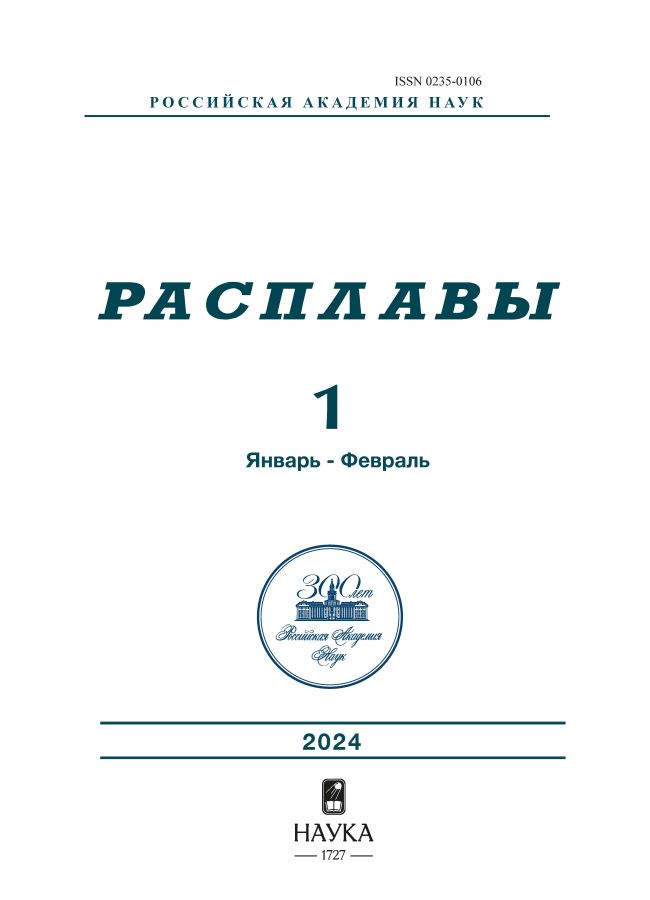Calculation of isothermal compressibility of potassium halide melts and in binary mixtures KI–KX (X = F, Cl, Br) by the classical molecular dynamics
- Autores: Kobelev M.1
-
Afiliações:
- Institute of high-temperature electrochemistry Ural branch of RAS
- Edição: Nº 1 (2024)
- Páginas: 101-108
- Seção: Articles
- URL: https://journals.rcsi.science/0235-0106/article/view/256468
- DOI: https://doi.org/10.31857/S0235010624010096
- ID: 256468
Citar
Resumo
Calculations of the isothermal compressibility (ᵡT) of individual potassium halides and some binary mixtures, namely KI–KX (X = F, Cl, Br), by using the classical molecular dynamics were carried out. Simulations of potassium halide melts using the Born-Mayer-Huggins pair potential showed good agreement between the calculated isothermal compressibility values and experimental data. A systematic underestimation of the calculated ᵡT values for individual melts was discovered, with the maximum difference between the calculated and experimental values being 24% for potassium chloride. For binary mixtures KI–KX (X = F, Cl, Br), the experimental concentration dependences of ᵡT during the transition from bromide ion to fluoride ion are characterized by an increasing deviation from additivity. It is shown, that even now for the binary mixture KI–KBr, the calculated concentration dependence ᵡT has a pronounced nonlinear dependence. At the same time, the maximum differences between the calculated and experimental values of ᵡT are observed for the KI–KF binary mixture of equimolar composition and are about 34%.
Texto integral
Sobre autores
M. Kobelev
Institute of high-temperature electrochemistry Ural branch of RAS
Autor responsável pela correspondência
Email: m.kobelev@ihte.ru
Rússia, Yekaterinburg
Bibliografia
- Porter T., Vaka M., Steenblik P., Corte D. Computational methods to simulate molten salt thermophysical properties // Commun. Chem. 2022, 5. P. 69.
- Yang H., Gallagher R., Chartrand P., Gheribi A.E. // Sol. Energy. 2023. 256. P. 158–178. https://doi.org/10.1016/j.solener.2023.04.009
- Galashev A.Y., Abramova K.A., Vorob’ev A.S. et al. // Electrochemical Materials and Technologies. 2023. 2. № 3. P. 20232017. https://doi.org/10.15826/elmattech.2023.2.017
- Shishido H., Yusa N., Hashizume H. et al. Thermal design investigation for a FLiNaBe blanket system // Fusion Sci. Tech. 2017. 72. № 3. P. 382–388.
- Sooby E., Baty A., Benes O., McIntyre P., Pogue N., Salanne M., Sattarov A. // J. Nucl. Mater. 2013. 440. № 1-3. P. 298–303. https://doi.org/10.1016/j.jnucmat.2013.04.004
- Минченко В.И., Степанов В.П. Ионные расплавы: упругие и калорические свойства. Екатеринбург: УрО РАН, 2008.
- Fumi F.G., Tosi M.P. // J. Phys. Chem. Solids. 1964. 25. P. 31–43. https://doi.org/10.1016/0022-3697(64)90159-3
- Ribeiro M.C.C. // J. Phys. Chem. B. 2003. 107. P. 4392–4402. https://doi.org/10.1021/jp027261a
- Wang J., Sun Z., Lu G., Yu J. // J. Phys. Chem. B 2014. 118. № 34. P. 10196–10206. https://doi.org/10.1021/jp5050332
- Frenkel D and Smit B Understanding molecular simulation: From algorithms to applications. Academic Press, 2002.
- Sangster M., Dixon M. // Adv. Phys. 1976. 25. P. 247–342. https://doi.org/10.1080/00018737600101392
- Larsen B., Forland T., Singer K. // Mol. Phys. 1973. 26. № 6. P. 1521–1532. https://doi.org/10.1080/00268977300102671
- Mayer J.E. // J. Chem. Phys. 1933. 1. № 4. P. 270–279. https://doi.org/10.1063/1.1749283
- Allen M., Tildesley D. Computer simulations of liquids. New York: Oxford University Press, 1987.
- Smirnov M.V., Stepanov V.P. // Electr. Acta. 1982. 27. № 11. P. 1551–1563. https://doi.org/10.1016/0013-4686(82)80082-0
- Nosé S. // Prog. Theor. Phys. Supp. 1991. 103. P. 1–46. https://doi.org/10.1143/PTPS.103.1
- Refson K. // Comp. Phys. Commun. 2000. № 3. P. 310–329. https://doi.org/10.1016/S0010-4655(99)00496-8
- Bockris J.O.M., Richards N.E. // Proc. Roy. Soc. A. 1957. 241. № 1224. P. 44–66. https://doi.org/10.1098/rspa.1957.0112
Arquivos suplementares












